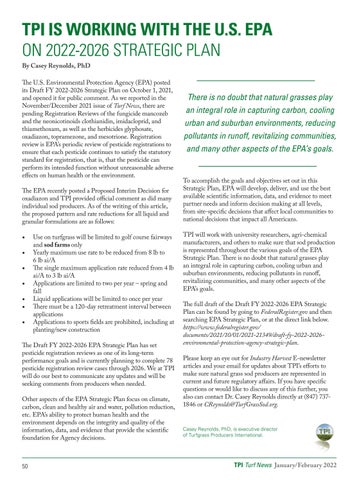TPI IS WORKING WITH THE U.S. EPA ON 2022-2026 STRATEGIC PLAN By Casey Reynolds, PhD The U.S. Environmental Protection Agency (EPA) posted its Draft FY 2022-2026 Strategic Plan on October 1, 2021, and opened it for public comment. As we reported in the November/December 2021 issue of Turf News, there are pending Registration Reviews of the fungicide mancozeb and the neonicotinoids clothianidin, imidacloprid, and thiamethoxam, as well as the herbicides glyphosate, oxadiazon, topramezone, and mesotrione. Registration review is EPA’s periodic review of pesticide registrations to ensure that each pesticide continues to satisfy the statutory standard for registration, that is, that the pesticide can perform its intended function without unreasonable adverse effects on human health or the environment. The EPA recently posted a Proposed Interim Decision for oxadiazon and TPI provided official comment as did many individual sod producers. As of the writing of this article, the proposed pattern and rate reductions for all liquid and granular formulations are as follows:
• • • • • • •
Use on turfgrass will be limited to golf course fairways and sod farms only Yearly maximum use rate to be reduced from 8 lb to 6 lb ai/A The single maximum application rate reduced from 4 lb ai/A to 3 lb ai/A Applications are limited to two per year – spring and fall Liquid applications will be limited to once per year There must be a 120-day retreatment interval between applications Applications to sports fields are prohibited, including at planting/new construction
The Draft FY 2022-2026 EPA Strategic Plan has set pesticide registration reviews as one of its long-term performance goals and is currently planning to complete 78 pesticide registration review cases through 2026. We at TPI will do our best to communicate any updates and will be seeking comments from producers when needed. Other aspects of the EPA Strategic Plan focus on climate, carbon, clean and healthy air and water, pollution reduction, etc. EPA’s ability to protect human health and the environment depends on the integrity and quality of the information, data, and evidence that provide the scientific foundation for Agency decisions.
50
There is no doubt that natural grasses play an integral role in capturing carbon, cooling urban and suburban environments, reducing pollutants in runoff, revitalizing communities, and many other aspects of the EPA’s goals.
To accomplish the goals and objectives set out in this Strategic Plan, EPA will develop, deliver, and use the best available scientific information, data, and evidence to meet partner needs and inform decision making at all levels, from site-specific decisions that affect local communities to national decisions that impact all Americans. TPI will work with university researchers, agri-chemical manufacturers, and others to make sure that sod production is represented throughout the various goals of the EPA Strategic Plan. There is no doubt that natural grasses play an integral role in capturing carbon, cooling urban and suburban environments, reducing pollutants in runoff, revitalizing communities, and many other aspects of the EPA’s goals. The full draft of the Draft FY 2022-2026 EPA Strategic Plan can be found by going to FederalRegister.gov and then searching EPA Strategic Plan, or at the direct link below. https://www.federalregister.gov/ documents/2021/10/01/2021-21349/draft-fy-2022-2026environmental-protection-agency-strategic-plan. Please keep an eye out for Industry Harvest E-newsletter articles and your email for updates about TPI’s efforts to make sure natural grass sod producers are represented in current and future regulatory affairs. If you have specific questions or would like to discuss any of this further, you also can contact Dr. Casey Reynolds directly at (847) 7371846 or CReynolds@TurfGrassSod.org.
Casey Reynolds, PhD, is executive director of Turfgrass Producers International.
TPI Turf News January/February 2022










